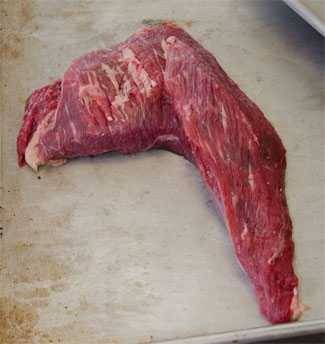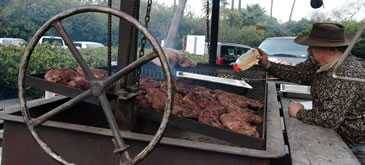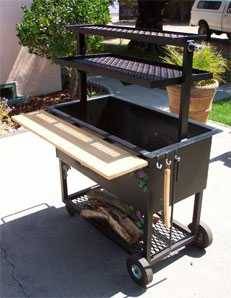In the beautiful Central Coast town of Santa Maria, there are big ranches, plenty of cattle, and an amazing cut of beef that was once unique to this area — the tri-tip.
Originally settled by Mexican cowboys called vaqueros, Santa Maria has an international reputation for their local specialty, tri-tip steak, the unique grill they invented to cook it, and the clever way they carve it to make it tender.
The story goes that in the 1950s a Safeway butcher named Bob Schutz was overstocked on ground beef and stew meat, so he took a curved muscle from the bottom sirloin usually destined for chopping or grinding, and put it on his store’s rotisserie. He and his staff were shocked at how flavorful and tender it was. He called it tri-tip and started promoting it as a barbecue meat. Nowadays, when you say barbecue in this beautiful slice of California, with beaches and mountains, you are talking tri-tip, not ribs or brisket.

Tri-tip is a crescent-shaped muscle from the bottom sirloin just in front of the hip. A typical tri-tip might be about 8″ (20cm) long, 3″ (8cm) wide in the center, and 3″ (8cm) thick in the center, tapering at the ends, and weighing 1.5 to 2 pounds (680.4g to 907.2g). It is available in every grocery and butcher shop in Southern California, but it is hard to find elsewhere. If you don’t live on the left bank, your butcher should be able to special order it. Tell her it is the tensor fasciae latae muscle from the bottom sirloin, and it is number 185C in the NAMP book, the butcher’s bible.
It has big beefy flavor, it is very lean, so it can be on the chewy side if you don’t cook and slice it properly. But cook and slice it the way they do in Santa Maria, and you can have a piece almost as tender, and every bit as juicy as prime rib. I call it the Poor Man’s Filet Mignon.

The Santa Maria style grill is perfect for this cut. It has a grate that can be raised or lowered with a wheel and pulley system so the grillmaster can control the heat on this thick hunk-o-flesh, crucial to get it done properly without burning it to a crisp. The model above is a large caterers rig and the small one below is from the Santa Maria BBQ Outfitters. The fuel of choice is Santa Maria is red oak logs.

The meat is prepped with minimal seasoning, typically just salt, pepper, and garlic powder, and served without sauce, so the big beefy flavor reigns. It is almost always taken off the grill when medium rare, the temp at which it is most tender, and accompanied by grill toasted bread to mop up the juices, a salsa, pinquito beans, macaroni and cheese, salad, and the excellent local wines.
Makes:
Takes:
Ingredients
- 3 pound tri-tip roast
- 1 1/2 teaspoons Morton Coarse Kosher Salt (approximately 1/2 teaspoon per pound of meat)
- 1/2 teaspoon coarsely ground black pepper
- 1 teaspoon garlic powder
- 1 teaspoon paprika
These recipes were created in US Customary measurements and the conversion to metric is being done by calculations. They should be accurate, but it is possible there could be an error. If you find one, please let us know in the comments at the bottom of the page
Method
- Prep. Pat the meat dry with paper towels. Two to three hours before cooking, sprinkle it with salt, no more than you would if you were served the cooked meat. This dry brining will dissolve and get pulled into the meat and season it throughout. You can dry brine the night before if you wish.
- Just before cooking, sprinkle it with the spices, roughly equal amounts, and massage it in. Don’t worry about over-seasoning. When you’re done you’re going to cut it into thin slices so each slice will have only a small lip of flavorful crust.
- Fire up. Set up your grill for 2-zone cooking with one side of your grill scorching hot and the other about 225°F to 250°F (107°C to 121.°C)
- Cook. Because this is a thick hunk of flesh, we can't put it close to high heat or the exterior will carbonize long before the center even warms. In Santa Maria, where the grills have a built-in elevator, they raise the meat up and flip it frequently during a cook that typically lasts as long as an hour. Unless you have a Santa Maria style grill (I have a Hasty Bake oven that is perfect for tri-tip because it cranks up and down like a Santa Maria grill), first put the meat on the indirect heat side of your grill with the thick end closer to the heat, close the lid, turn it every 20 minutes or so, and wait until the center hits about 110 to 115°F (43°C to 46°C), below your target temp. This can take 30 to 45 minutes, but you must use a good digital instant read thermometer to get the temp right, especially if you are not experienced with this cut. Then move over direct high heat for about 5 minutes per side or until it gets a nice dark even sear. I like to take it up to about 130°F (54°C) for medium rare. I know this is different than they do it in Santa Maria where they sear the meat first, but the fact is, this method is better. You will get a more even color through the meat if you sear in the rear.
- Remove the tri-tip from the grill. Now here's the trick to carving it. Begin with a carving board that has deep valleys cut into it or else the juice will run away from you. You will not believe how wet this is if cooked medium rare or less.
- Cut the muscle in half first.

- Then rotate each half and cut it from the tip to the cut end, across the grain, in 3/8 to 1/2" (9.5mm to 12.7mm) slices. Cutting across the grain insures that it will be easier to chew.

- The top slice is cut properly across the grain. It will be easier to chew. The bottom slice is cut with the grain. It will be stringier and harder to chew.

- Serve. Fan the slices on a platter, pour the juices on top, and serve with grilled garlic bread to sop up the juices. If there are any leftovers, store it and the juices, and it makes great sandwiches.



High quality websites are expensive to run. If you help us, we’ll pay you back bigtime with an ad-free experience and a lot of freebies!
Millions come to AmazingRibs.com every month for high quality tested recipes, tips on technique, science, mythbusting, product reviews, and inspiration. But it is expensive to run a website with more than 2,000 pages and we don’t have a big corporate partner to subsidize us.
Our most important source of sustenance is people who join our Pitmaster Club. But please don’t think of it as a donation. Members get MANY great benefits. We block all third-party ads, we give members free ebooks, magazines, interviews, webinars, more recipes, a monthly sweepstakes with prizes worth up to $2,000, discounts on products, and best of all a community of like-minded cooks free of flame wars. Click below to see all the benefits, take a free 30 day trial, and help keep this site alive.
Post comments and questions below
1) Please try the search box at the top of every page before you ask for help.
2) Try to post your question to the appropriate page.
3) Tell us everything we need to know to help such as the type of cooker and thermometer. Dial thermometers are often off by as much as 50°F so if you are not using a good digital thermometer we probably can’t help you with time and temp questions. Please read this article about thermometers.
4) If you are a member of the Pitmaster Club, your comments login is probably different.
5) Posts with links in them may not appear immediately.
Moderators